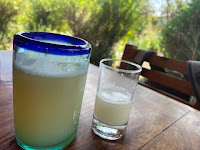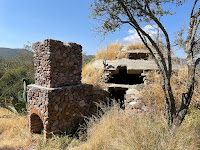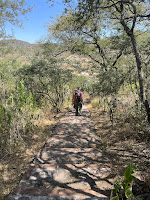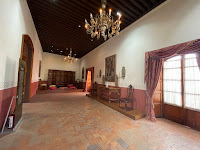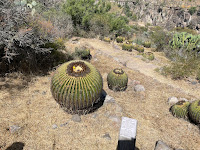According to Rancho Via Organica's Web site, approximately 50% of Mexico's land is semi-arid and degraded, in part by industrial agriculture.
Agave plants, which can grown on degraded semi-arid land, can produce up to one ton of biomass over their 8-10 year lifespan. When chopped and fermented in closed containers, this plant material produces an excellent, inexpensive (two cents per pound) animal fodder.
The agave plants are grown in companion with mesquite trees. The bean pods of these trees can be used to produce nutritious mesquite flour.
Together, these plants can produce 43 tonnes of biomass per hectare per year, reduce pressure created by livestock overgrazing, improve soil health and water retention, protect pollinating insects, and store billions of tonnes of CO2.
Pictures
1) There is a lovely restaurant at Via Organica with a pretty extensive and interesting menu. There, I drank aguamiel and pulque, both from the sap of the agave plant. Agualmiel (honey water) is the sap of the agave plant which is harvested by making an incision into the heart of a large growing plant. I'm not sure if the sap was mixed with water and sugar. Maybe, maybe not. Pulque is fermented aguamiel. Both are considered to be very good for the digestive system and health. Sadly, I did not enjoy either. Though Rosie quite liked the pulque!2) At the Via Organica restaurant, I ate rabbit meat for the first time in my life, in a hamburger. The picture is a bit ironic...3) Chickens! The chickens with no feathers on their necks are not sick or being picked on. This is their natural way of being. Maybe it's cooler on the hot days?! Every few months, Via Organica moves the chicken run to the other side of the coop for the benefit of the soil and the chickens.
4) The ruins of a temascal.
5) The view from the mirador (look out) at Via Organica was beautiful!!
6) a Building that once was the office for Via Organica. Now, not in use except the roof, which is used as a lookout.7) Rosie and our guide walking down one of the many paths
8 &9 ) Via Organica has a seed bank. Rosie took this beautiful picture of the seeds and a butterfly
10) The kale plants in the garden are so tall, they look like they belong in a Dr Seuss book!
